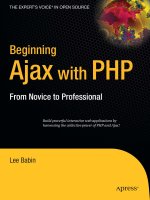Modeltomodel transformation with ATL
Bạn đang xem bản rút gọn của tài liệu. Xem và tải ngay bản đầy đủ của tài liệu tại đây (543.68 KB, 59 trang )
Model-to-model Transformation with ATL
Frédéric Jouault (INRIA)
Brahim-Khalil LOUKIL (INRIA)
William Piers (Obeo)
© 2008 by INRIA, Obeo; made available under the EPL v1.0 | 17 March 2008
Agenda
• Introduction
Model-To-Model transformation in the MDE field
M2M vs. M2T
• ATL Overview
Available resources: wiki, zoo, newsgroup, use cases, etc.
ATL language description
• First exercise: Ecore-To-UML2.1
• Architecture
Overview
The new virtual machine: EMF-VM
• Second exercise: GMF Diagram Refactoring
• Third exercise: Public-To-Private
Model-To-Model Transformation with ATL | © 2008 by INRIA, Obeo; made available under the EPL v1.0
Agenda
• Introduction
Model-To-Model transformation in the MDE field
M2M vs. M2T
• ATL Overview
Available resources: wiki, zoo, newsgroup, use cases, etc.
ATL language description
• First exercise: Ecore-To-UML2.1
• Architecture
Overview
The new virtual machine: EMF-VM
• Second exercise: GMF Diagram Refactoring
• Third exercise: Public-To-Private
Model-To-Model Transformation with ATL | © 2008 by INRIA, Obeo; made available under the EPL v1.0
ATL - Description
• ATL : ATLAS Transformation Language
• ATL is a language and a virtual machine dedicated to
model transformation
• ATL is an Eclipse Model-to-Model (M2M) component,
inside of the Eclipse Modeling Project (EMP)
Model-To-Model Transformation with ATL | © 2008 by INRIA, Obeo; made available under the EPL v1.0
Definitions
• A model transformation is the automatic creation of
target models from source models.
• Model transformation is not only about M1 to M1
transformations:
M1 to M2: promotion,
M2 to M1: demotion,
M3 to M1, M3 to M2, etc.
M3
Metametamodel
M2
Metamodel
M1
Terminal
Model
Model-To-Model Transformation with ATL | © 2008 by INRIA, Obeo; made available under the EPL v1.0
Operational context: small theory
conformsTo
Metametamodel
Class
Class
conformsTo
conformsTo
MMa
ATL
Class
Class
Green
Rule
MMb
Blue
Class
Class
Red
conformsTo
Ma
Class
MMa2MMb.atl
Rule
Rule
R2B
G2P
Pink
conformsTo
Mb
Model-To-Model Transformation with ATL | © 2008 by INRIA, Obeo; made available under the EPL v1.0
Operational context of ATL
MOF
MMa is the
source
metamodel
ATL
MMa
Ma
MMb
MMa2MMb.atl
Ma is the source model
MMB is the
target
metamodel
Mb
Mb is the target model
Model-To-Model Transformation with ATL | © 2008 by INRIA, Obeo; made available under the EPL v1.0
M2M vs. M2T
• M2M: Model To Model transformation
Abstract syntax to abstract syntax
Languages: ATL, QVT Operational, QVT Relations
• M2T: Model To Text transformation
Abstract syntax to concrete syntax
Languages: JET, xPand
• TMF: Textual Modeling Framework
Abstract syntax to and from concrete syntax
Languages: TCS, xText
• This tutorial is focused on M2M
Model-To-Model Transformation with ATL | © 2008 by INRIA, Obeo; made available under the EPL v1.0
Agenda
• Introduction
Model-To-Model transformation in the MDE field
M2M vs. M2T
• ATL Overview
Available resources: wiki, zoo, newsgroup, use cases,
etc.
ATL language description
• First exercise: Ecore-To-UML2.1
• Architecture
Overview
The new virtual machine: EMF-VM
• Second exercise: GMF Diagram Refactoring
• Third exercise: Public-To-Private
Model-To-Model Transformation with ATL | © 2008 by INRIA, Obeo; made available under the EPL v1.0
ATL history
• 1990 : first works on model transformation
• 1998 : initial publication for a Ph.D. thesis at the
University of Nantes
• 1998 - 2004 : Implementation
CARROLL/MOTOR project (CEA, Thales, INRIA)
Collaborative projects : ModelWare, ModelPlex, OpenEmbeDD
• 2004 : Eclipse GMT integration
• 2006 : Industrial solution inside of the Eclipse M2M
project
Model-To-Model Transformation with ATL | © 2008 by INRIA, Obeo; made available under the EPL v1.0
ATL community
• Active community
Newsgroup: news://news.eclipse.org/eclipse.modeling.m2m
Wiki: />Bugzilla
Use cases: />Transformations zoo (i.e., a library):
/>
• Other links :
Project page: />
Model-To-Model Transformation with ATL | © 2008 by INRIA, Obeo; made available under the EPL v1.0
ATL transformation zoo
-- Rule 'ComplexReference'.
-- This rule generates two opposites references which will be the link
-- between the new Relationship and his adjoining Classes
rule ComplexReference {
from
r : DSL!Role (
r.relation.needTurnOnClass()
)
using {
oppositeRole : DSL!Role = r.relation.roles->select(e | e <> r)->first();
}
to
rfInOwner : KM3!Reference (
name <- r.name,
owner <- r.source,
type <- r.relation,
opposite <- rfInRelationship,
lower <- r.min,
upper <- if r.max=0
then 0-1 else 1 endif,
isOrdered <- r.isOrdered,
isContainer <- r.isEmbedding(),
isUnique <- false
),
rfInRelationship : KM3!Reference (
name <- oppositeRole.name,
owner <- r.relation,
type <- r.source,
opposite <- rfInOwner,
lower <- oppositeRole.min,
upper <- if oppositeRole.max=0 then 0-1 else 1 endif,
isOrdered <- oppositeRole.isOrdered,
isContainer <- oppositeRole.isEmbedding(),
isUnique <- false
)
}
Model-To-Model Transformation with ATL | © 2008 by INRIA, Obeo; made available under the EPL v1.0
Model-To-Model Transformation with ATL | © 2008 by INRIA, Obeo; made available under the EPL v1.0
ATL overview
• Source models and target models are distinct:
Source models are read-only (they can only be navigated,
not modified),
Target models are write-only (they cannot be navigated).
• The language is a declarative-imperative hybrid:
Declarative part:
Matched rules with automatic traceability support,
Side-effect free navigation (and query) language: OCL 2.0
Imperative part:
Called rules,
Action blocks.
• Recommended programming style: declarative
Model-To-Model Transformation with ATL | © 2008 by INRIA, Obeo; made available under the EPL v1.0
ATL overview (continued)
• A declarative rule specifies:
a source pattern to be matched in the source models,
a target pattern to be created in the target models for each
match during rule application.
• An imperative rule is basically a procedure:
It is called by its name,
It may take arguments,
It can contain:
A declarative target pattern,
An action block (i.e. a sequence of statements),
Both.
Model-To-Model Transformation with ATL | © 2008 by INRIA, Obeo; made available under the EPL v1.0
ATL overview (continued)
• Applying a declarative rule means:
Creating the specified target elements,
Initializing the properties of the newly created elements.
• There are three types of declarative rules:
Standard rules that are applied once for each match,
A given set of elements may only be matched by one standard
rule,
Lazy rules that are applied as many times for each match as
it is referred to from other rules (possibly never for some
matches),
Unique lazy rules that are applied at most once for each
match and only if it is referred to from other rules.
Model-To-Model Transformation with ATL | © 2008 by INRIA, Obeo; made available under the EPL v1.0
Declarative rules: source pattern
• The source pattern is composed of:
A labeled set of types coming from the source metamodels,
A guard (Boolean expression) used to filter matches.
• A match corresponds to a set of elements coming
from the source models that:
Are of the types specified in the source pattern (one element
for each type),
Satisfy the guard.
Model-To-Model Transformation with ATL | © 2008 by INRIA, Obeo; made available under the EPL v1.0
Declarative rules: target pattern
• The target pattern is composed of:
A labeled set of types coming from the target metamodels,
For each element of this set, a set of bindings.
A binding specifies the initialization of a property of a target
element using an expression.
• For each match, the target pattern is applied:
Elements are created in the target models (one for each type of the
target pattern),
Target elements are initialized by executing the bindings:
First evaluating their value,
Then assigning this value to the corresponding property.
Model-To-Model Transformation with ATL | © 2008 by INRIA, Obeo; made available under the EPL v1.0
Execution order of declarative rules
• Declarative ATL frees the developer from specifying
execution order:
The order in which rules are matched and applied is not
specified.
Remark: the match of a lazy or unique lazy rules must be
referred to before the rule is applied.
The order in which bindings are applied is not specified.
• The execution of declarative rules can however be
kept deterministic:
The execution of a rule cannot change source models
Î It cannot change a match,
Target elements are not navigable
Î The execution of a binding cannot change the value of
another.
Model-To-Model Transformation with ATL | © 2008 by INRIA, Obeo; made available under the EPL v1.0
Example: Class to Relational - Overview
• The source metamodel Class is a simplification of
class diagrams.
• The target metamodel Relational is a simplification of
the relational model.
Î ATL declaration of the transformation:
module Class2Relational;
create Mout : Relational from Min : Class;
• The transformation excerpts used in this presentation
come from:
/>
Model-To-Model Transformation with ATL | © 2008 by INRIA, Obeo; made available under the EPL v1.0
Example: Class to Relational - Source Metamodel
NamedElt
+name:String
Classifier
+ type
DataType
Class
+ attr
Attribute
+multivalued:Boolean
owner
*
{ordered }
Model-To-Model Transformation with ATL | © 2008 by INRIA, Obeo; made available under the EPL v1.0
Example: Class to Relational – Target Metamodel
Named
+name:String
Table
+ col
Column
*
+ type
Type
+ owner
*
{ordered}
+ keyOf
0..1
+ key
*
Model-To-Model Transformation with ATL | © 2008 by INRIA, Obeo; made available under the EPL v1.0
Example: Class to Relational, overview
• Informal description of rules
Class2Table:
A table is created from each class,
The columns of the table correspond to the single-valued
attributes of the class,
A column corresponding to the key of the table is created.
SingleValuedAttribute2Column:
A column is created from each single-valued attribute.
MultiValuedAttribute2Column:
A table with two columns is created from each multi-valued
attribute,
One column refers to the key of the table created from the
owner class of the attribute,
The second column contains the value of the attribute.
Model-To-Model Transformation with ATL | © 2008 by INRIA, Obeo; made available under the EPL v1.0
Example: Class to Relational - Rule
Class2Table (1 Of 4)
• For each Class, create a Table :
rule Class2Table {
from
-- source pattern
c : Class!Class
to
-- target pattern
t : Relational!Table
}
Model-To-Model Transformation with ATL | © 2008 by INRIA, Obeo; made available under the EPL v1.0
Example: Class to Relational - Rule
Class2Table (2 Of 4)
• The name of the Table is the name of the Class:
rule Class2Table {
from
c : Class!Class
to
t : Relational!Table (
name <- c.name
)
}
-- a simple binding
Model-To-Model Transformation with ATL | © 2008 by INRIA, Obeo; made available under the EPL v1.0









